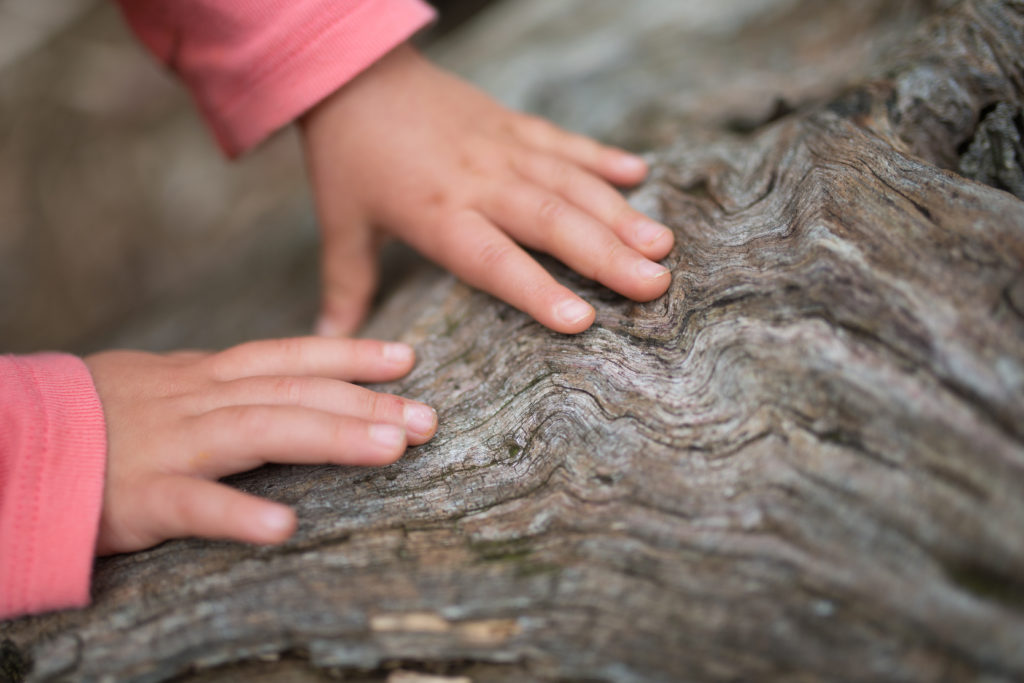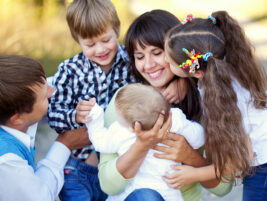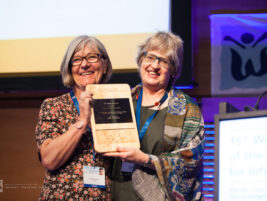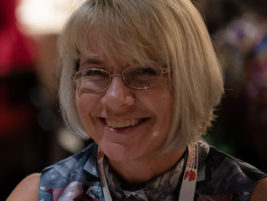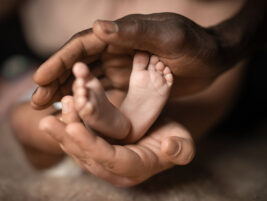As a creative pioneer in the field of infant mental health, Dr Ann Morgan has provided immense support and leadership for those working with troubled infants and their families. She has been a passionate advocate for infants and parents, providing transformational interventions for them and inspiration for her colleagues.
To honour Dr Ann Morgan’s contribution to the infant mental health field, the Australian Association for Infant Mental Health, Inc. Victoria has established an annual writing prize, the Ann Morgan Prize. It was first inaugurated in 2010 as a way of honouring Ann when she retired from her official role on the AAIMHI (Vic) committee as Vice- President.
The Ann Morgan Prize was created to invite contributions that would illuminate something about the infant’s experience and also to be a forum for creative writing not bound by the rules and restrictions defining many professional publications. The invitation to submit is extended to all members of the Australian Association for Infant Mental Health.
Heather Warne received the Ann Morgan Prize in 2015. She was originally trained as an occupational therapist and has spent most of the past 35 years working with children and families in community health settings. Over the past 15 years, she has found her way into the fields of psychotherapy and infant mental health. Heather works as an infant mental health specialist with the Infant Therapeutic Reunification Service based at the Women’s and Children’s Hospital in Adelaide and maintains a small private practice.
The Infant Therapeutic Reunification Service is a collaborative health and child protection initiative working with parent/s and infants where the infant has suffered abuse or neglect. The service provides comprehensive parenting capacity assessment and where possible, therapeutic intervention that aims to increase the parent’s protective and reflective capacities within the developmental time frame of the infant. The focus of the work is primarily on building relationships.
The service provides early assessment and intensive parent/infant therapy for infants under three and their parents, where significant maltreatment and neglect has occurred, or is at risk of occurring. It was set up in 2011 in response to the high levels of infants coming into care and often experiencing multiple placements. Based on the Tulane Infant Team model, the success of the reunification work is higher than average.
Where reunification is not possible, timely long-term decisions that address the infant’s developmental timeframe are made and therapy with foster parents and infants may also be offered.
At all levels of intervention the focus is to build reflective capacity to improve outcomes for infants.
The client in the story has generously given permission for the work to be published and presented.
First published in the AANZPA Journal, the article appears here with permission from the authors, Patricia O’Rourke and Heather Warne, and the publisher.
O’Rourke, P.M. & Warne H. (2015). Psychodrama and Infant Mental Health: An essay and a conversation. AANZPA Journal, 24, p.29-37.
Moments from inside an Infant Therapeutic Reunification Service…
He turns up regularly, weekly, though sometimes la. Today he’s on time, and sits awkwardly in the waiting room. He’s thick set, 24 years old, pumps weights and drinks Red Bull. He never wears a jumper. His baby, a girl, soon to be a toddler, sits in her pusher, face slightly dirty, big blue eyes alert, wispy hair awry and poking out from under a red and white knitted hat with red pom poms dangling from the ear flaps. Her feet are bare. Today she grins at me, a wide toothy smile – she has a big gap between those two front teeth, and she looks just like her dad. Although her paternity is obvious, in the beginning it was contentious and required scientific verification.
He is less effusive in his greeting, doesn’t directly say hello. He’s a bit shy, and socially awkward. The greeting is important. Sometimes our parents can’t share, not even with their infant, and it can be a mistake to greet the infant first; if the parent flickers, and turns away just slightly with dry displeasure, we’re off to a bad start. This dad is not like that, but he is on the edge of his comfort zone, here under duress. Mostly he warms up as we trundle down the corridor, through the grey security door then right, left, left and into the playroom. He reminds me of a friendly but slightly inept bear with a dolly in a flimsy toy pusher.
Usually he connects with me, on his own terms, by way of cars. He relates his latest mechanical exploits – the new shockers he’s just installed on the V6, the deal he’s wrangled for good second-hand tyres, and after this (meaning the session), he’s off to the wreckers with his dad because the timing belt is on its way out. I will ask him again, a little later, about where the baby will be and I’ll say something like, ‘Wow that’s a long time for her to sit in the car …’ And he will say, ‘Oh she’s used to it,’ and I will grapple with how much of a problem it is in the general scheme of things.
But today it’s a bit different – he sucks on his can of Red Bull and fiddles with his phone as he pushes her along. He’s not looking at me. Just as we get to the room his phone rings, and he says can he answer it? Perhaps he’s remembering last time, when, sitting on the floor with the baby, I relayed what I felt, what the baby might feel, as he texted back and forth, one of the candidates he was vetting for a relationship. Perhaps he’s remembering something of that conversation, carefully delivered with humour and empathy, so as not to shame him. I said how I felt alone and forgotten right then and there, while he held his phone, in his hands and his mind, and it was probably like that for his baby too. He scrabbled about, keen to tell me that the ‘chick’ on the receiving end of his attentions was only free now, since it was lunchtime … How would he manage, I wondered out loud, the romance and compulsion of a new relationship, while caring for a baby? Easy he said, we’d only do stuff where she could come too. He has criteria, has learned from his mistakes, he says. Good with kids is on top of his list, and he can provide details.
But maybe he did feel criticised, or there’s something else on his mind. Whatever it is, the baby is here, however he feels, and how does he manage that? She’s off by herself, busy with the toys, but she looks at him more than when they first came; she was eight months old. Now she’s almost walking and he’s keen for her to be properly mobile. Small babies are not really his thing.
There’s no doubt she’s in his heart, I can feel it in the room. He no longer goes out drinking, he doesn’t tangle with the law. He’s solid and reliable and committed. He’s recently been shopping for her, for new clothes, and, apart from the hat, she’s decked out in pink. Sometimes she arrives buttoned at the front when I’m pretty sure the buttons belong at the back. Her bottles are clean, and he tells me she gobbles up the vegies he cooks for her. She’s healthy, growing well, and meeting her developmental milestones – a far cry from the emaciated, silent, dull-eyed infant who arrived, aged four months, precipitously into his care.
Our service, small, committed, and meagrely resourced, works with infants and parents at risk. All of our clients are involved with the child protection system. Our job is to put the infant first; we grapple with the complexities of parenting capacity assessment, out-of-home care, early decision-making in the best interests of the infant and within their developmental timeframe, and where possible, intensive therapeutic support with the infant and their parent/s or carer/s. Most of our therapeutic work is with mothers and their infants, most of the fathers are violent and don’t have what it takes.
This father, however, is not violent, and took on his daughter’s care when the mother couldn’t do it. Within the hour he’d said yes, and had rallied his network and the basic necessities – cot, nappies, bottles and formula, singlets and grow suits and blankets. Fatherhood was huge for him, and he took it on. She arrived from her mother via a child protection worker, a haunted shell. Her mother was homeless and mostly drugged. This infant, like many we see, had witnessed violence, ugly and terrifying. She was left alone, to scream and despair, her bottles filthy and unfilled. She spent days at a time with mere acquaintances when her mother failed to return. She’d been seriously ill and was way too thin, admitted to hospital for ‘failure to thrive’. Her body told the story. Her mother, repeating her own history, did not know how to do it differently.
He had fallen into a relationship of sorts when the mother was ‘up’. They met through a friend, and for a few good weeks, she was fun loving and affectionate; then she moved in. She needed somewhere to stay. They talked about children, but she didn’t stay faithful. He found the evidence on her phone. By then she was pregnant, and stealing his money, and leaving her other child in his care. He left, or threw her out, it’s not clear which. He never went back. She alleged that he threatened their unborn child and took up again with a man who beat her. The father, our client, wasn’t at the birth, and she disputed paternity. Hence the test.
He’s not good at relationships, he says. As a boy he was angry, difficult to manage, and struggled at school. He received a dual diagnosis that has stuck. Asperger’s Syndrome and ADHD. Heavily medicated to keep him compliant, he gained huge amounts of weight, and thus dulled and conspicuous, struggled more at school. He started drinking and thieving, and ‘got in with the wrong crowd’. It seems no one heeded that he lived in fear, his father drank and abused his mother. When his parents separated, home was a toxic soup of blame and acrimony. When we talk about it now, he glides over the pain, says his father has given up the drink, goes fishing instead, and that he, the grandfather, has Asperger’s as well. The idea that something else was going on is very difficult to face and he doesn’t appear to have taken in the recent psychiatric opinion that he was labelled wrongly…
He says he doesn’t think his baby has Asperger’s, and I agree. We edge about it some more. Trauma can look like Asperger’s, I say, and again we talk about her brain, what all those stress hormones do to a small baby, how she learned not to rely on anyone and what she needs now. He says he’s getting better at that, and I agree. At some point, he gathers her in, a bit rough, but he holds her close and for a moment she snuggles in. She goes to him more. There’s an authentic quality in what he says, and I trust it. He says he’s not good at the feeling stuff, and finding a way to say things.
And so it goes. We talk about the past, and what happens in the moment. I try to give to him what I want him to give to her. I wonder what he’s thinking and feeling, what does he imagine she’s thinking and feeling, tell him what I see him doing, let him know that I like him and know him to be a good person, understand that parenting is hard. Especially when you weren’t expecting it and are going it alone when you really want a family, different from when you were little. Back and forth we go, between the baby and him, including both. What do you think that’s like for her? Did you see what she did when you sat on the floor? What do you think it’s like for her to see her mother? Is she any different when she gets home? This sounds like an interrogation, but I hope it’s not. It’s to and fro, joining them up, making links that weren’t obvious before.
And I talk about how weird it is to come in here and talk to someone as old as me in ways that he’s not used to and not comfortable with and is anything we’re doing here helpful because sometimes it’s hard to tell … and at regular intervals he talks about cars. He’s not deterred by my ignorance.
Although awkward and at times repetitive, these sessions are not that difficult. Despite some worries about the time this baby spends in the car and wrecking yards, and sitting in her playpen next to the latest being worked on vehicle, this dad is good enough. He knows his baby, thinks about her, plans for her. He accepts help. And she relies on him. She makes a beeline for him when she’s hurt or frightened, looks for him and cries when he’s not there. Though she’s too self-sufficient, and cruises the furniture on tiptoes, and parts of her are hidden, she is safe, and held in his arms and mind.
Not so, for others that we see. Young infants, for example, with unexplained bruising or broken bones, the ones who hold themselves rigid and stare with hopeless eyes into the distance, the ones who look down, with flat lifeless faces and their hair worn away in telling patches from too much lying down or rocking back and forth. The ones who spit up their milk and scream without warning, or the ones who are eager and overbright and latch on to strangers with desperate eyes. These are the ones who are not safe and not seen, and exist in helpless desperation.
As I recall the many such infants who come in through that grey security door, part of my brain disengages, and something else, akin to instinct, takes over, as it does in the room. The language of young infants is powerful and primitive. It is as if they speak through the feeling states that they evoke, how they hold themselves, and where they look. Infants cannot lie. They cannot help but tell the truth of their experience, the truth of their connection with the adult who holds them. Feeling states that are difficult to bear invade the room. Helpful theories and models simply evaporate, and, just as the infant cannot escape, I feel as if I am living on wits alone, with nowhere to hide. Trapped in their bodies, exquisitely sensitive, and helplessly vulnerable, the infant has no choice in the matter … the best they can do is to not look, hold themselves rigid, go still and silent and sometimes floppy, or overly bright and wide eyed, whichever serves them best. There’s such rawness in the room, so much excruciating need. And there is always more than one baby, though only one is visible. The mother’s infant self, as well as mine, are also present.
The mothers we work with are always wounded, horribly wounded, and champions of survival. They say the things that, logically, we would want to hear, and they trust no one.
‘Good mother, no drugs, no violence, reformed, unfairly treated, love my baby, baby perfect, a few past hiccups but all good now. No one will listen, it’s so unfair, I’ve done nothing wrong, I really am a good mother, had a few issues keeping things tidy, I’m not seeing the father, the baby is perfect, my world, my life, I’ll do anything for him. I will get him back, I know it. It’s just a matter of time and showing up here. I’ve done everything they’ve asked of me.’
How can she believe, though we’ve made it clear, that her best chance is to tell the truth? In her mind the truth, some version of this, would surely seal her fate: her childhood, or what little she remembers of it, was awful. She didn’t feel safe, wasn’t safe. From early on, she knew violence, abuse, neglect, terror, abandonment, and utter aloneness. She learned to numb herself. At some point, often very young, she fell pregnant. The promise of a baby, as if by magic, would fill the void. Here at last was someone who would love her, and not leave her.
It was not as she’d hoped. The infant screamed, was helpless, needed her. There was no one to help, she trusted no one to help. The partner, jealous, became more violent. She did her best, but sooner or later, she spiralled down, and reports were made. Or even worse, she’d been through it all before, once, twice, three times or more, and they took the baby early, straight from hospital …
We search for the signs that show she recognises her part. She has, though she did not mean to, hurt her baby. Either directly, or indirectly, either way the baby was not safe, as she was not safe. She has to see that she has done to her baby what was done to her, and to face the shame of that. She needs to face and to feel what that was like for her baby. Then we can work with her, that little chink in her armour.
The process will be long, imperfect and blundering, with moments of triumph and no guarantee of success. We will sit through session after session of rage and blame, anguish and grief. It will be the infant who leads the way; he will turn in circles, or back away, he will spill his jumbled world onto the floor. We will sit with chaos, sit in chaos, amongst a sea of plastic coins, pots and pans and teacups, dinosaurs and crocodiles, wild animals and items from a doctor’s set. It will be a long time before the train tracks join up and the train doesn’t crash. We will wait for the crocodiles to move out of the doll’s house. We will try to make sense of it all, and see through the infant’s eyes.
My part will be to show up regularly and willingly. The process will challenge me to the core, to sit with what is not contained, to hold a boundary, to stay thinking and connected, with myself and them. At best we will build enough safety for a real relationship to emerge, one in which vulnerability can be shown, pain can be held, and soothing experienced. It will be difficult to get there. The work requires a team, regular supervision, and a shared belief that change is possible; intergenerational trauma does not have to go on and on.
They’re back, the dad and his baby. They’re fifty minutes late. I go to the waiting room, pleased to see them; I thought they weren’t coming. She’s straining to get out of her pusher, and missing a sock. He’s dishevelled but upbeat. They have been on holiday to see his mum and celebrate the baby’s first birthday. They’ve been on the road since early morning, have just arrived in town. I take a breath and imagine them, flying down the highway in the V6 with the spoiler on the boot and her strapped into the baby seat, staring out the window with eyes glazing over, or asleep. I’m glad they’re safe. It’s not that he’s keen to see me; he’s in trouble with his social worker for missing access, and he didn’t dare not show up. Nevertheless, he bubbles with news. His mum is proud of him, she even said so, and they went camping, all together, and cooked lamb on a spit. The baby had a great time too, he said, and his best mate has just become a father. He wants to move back to the town he grew up in. It’s as if in claiming his baby he has also been claimed, back into his family.
A while ago I asked if I could write about them, and told him why. He laughed, a bit bemused and said ‘yeah, sure’, as long as he didn’t have to write anything.
The next thing, he says, will be to take her fishing, out in the boat. I feel instantly queasy, and I say so. He’s been thinking about that, the way he got his sea legs was to get started early, when he was five. She’s only one, I say. We’ll just do little trips, he says, and if she’s not okay, we’ll turn around and go back in. He’s saving up for a very small life jacket.
Note: The authors suggest the consideration of reflective questions, useful for inviting further thought about the story, individually or within a group:
Reflective Questions
What was your emotional response to this story and how does this relate to your own experience of working with parents and infants?
How do you feel about working with fathers and infants?
In your experience how does father-infant therapy differ from mother-infant therapy?
How could you use this father’s interest in cars and mechanics to build both the therapeutic and father-infant relationship?
What are the strengths and risks that this father brings to the relationship with his daughter? How would you weigh up the risk and protective factors and how would you manage the risks?
Authors
Ann Morgan Prize, Australian
Association for Infant Mental Health,
Inc. Victoria, Australia


